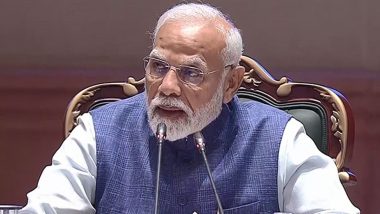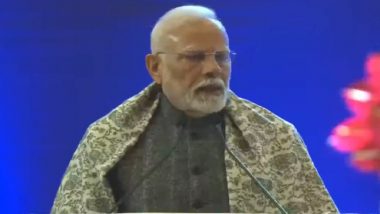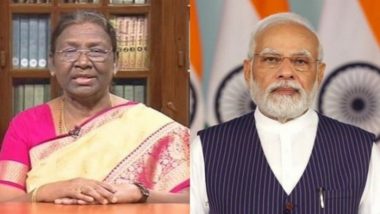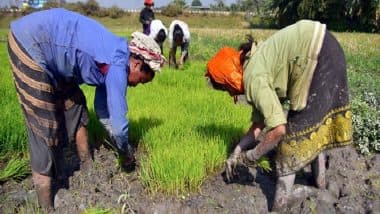Vijayapura, April 30: Prime Minister Narendra Modi had tasted northern Karnataka's famous 'Korati-Kolhar curd' in Vijayapura district yesterday that was supplied from Kolhar taluk in Basavana-Bagewadi Assembly constituency where dairy farmers are facing acute fodder shortage and unable to continue buffalo rearing for sustenance.
'Korati-Kolhar curd', which is made from buffalo milk and solidified in a specially-made earthen pot, has been popular in Karnataka for its unique taste and thickness. This curd has been sold in Kolhar for over a decade now and it is tastier and cheaper than the modern, processed ones.
Former Prime Minister Atal Bihari Vajpayee, national leaders like B C Khanduri, Buta Singh and most recently J P Nadda and Rajnath Singh have tasted this curd. No wonder, tourists on the Hubli-Humnabad National Highway-218 stop here to get a taste of the homemade curd sold in earthen pots. Mann Ki Baat 100th Episode of PM Narendra Modi's Broadcast Live in UN Headquarters.
"A local leader asked me to supply Korati-Kolhar curd that will be served as one of the items as part of northern Karnataka cuisine to the Prime Minister. I supplied 60 small earthen pots of curd, which was tested in the lab before serving it to the PM," Rajashekar Mallikarjun Guddadur told PTI.
A fourth generation member running a curd shop on NH-218, Guddadur says he was "very happy" when the curd from his outlet was tasted by the Prime Minister. Given its rising popularity, Guddadur said there is a huge demand for this special curd on NH-218 itself but laments that the supply has not been enough. The reason for the shortage being dairy growers in the village finding it difficult to scale up curd making due to lower milk production in Kolhar town.
"For a buffalo to give good quality and quantity of milk, the fodder is the key. Dairy growers are finding it hard to get quality fodder for their buffaloes and therefore not rearing more animals," said Guddadur, who sells about 500 pots a day at his shop.
What goes into this curd that makes it delicious is nothing but nutritious fodder that buffaloes eat and that helps give good quality milk with which curd is made.
"Earlier, we used to feed residues of some locally grown pulses and maize crops. There used to be enough open fields for grazing. Now, all this has been reduced. Farmers are only growing commercial crops like sugarcane leaving no space for livestock grazing. This has created a fodder shortage here," said dairy farmer Hanumantha Nyamagonda.
Nyamagonda used to rear 10 buffaloes a few years back and now has only four such animals due to difficulty in arranging good quality fodder from faraway places. Parushuram Gani, a dairy farmer-cum-local journalist, said the place used to be an arid area till the availability of backwater from the Almatti dam and implementation of irrigation projects. This encouraged farmers to go for sugarcane and other commercial crops here, creating fodder problems.
The problem has become so acute that only those farmers who have some piece of land and can leave some space for animal grazing are surviving. Those who have space to rear buffaloes but not for grazing are gradually giving up and doing it only for personal consumption.
Gani also mentioned that sugarcane residue is hard and not suitable as fodder for buffaloes. Still, many farmers are feeding this due to which the quality of milk has deteriorated. Another problem is that those who are keen to buy buffaloes are not able to get financial help despite some schemes that are in place, he added. Mann Ki Baat 100th Episode Today: PM Narendra Modi’s Monthly Radio Programme Created a Revolution, Says Telangana Governor Tamilisai Soundararajan.
When he was young, Gani was the one who used to sell curd on the NH-218 in the 1980s when former Union Home Minister Buta Singh had stopped his vehicle wondering what was being sold in an earthen pot. Singh tasted the curd from the hands of Gani and liked it so much that he even carried a parcel of few curd pots with him.
"At that time, I was in my 20s. When I gave the curd to Buta Singh on this highway, the security guards immediately rushed to me to check what I was selling to the minister," recalled Gani, who is now 56. According to M N Patil, a government veterinary doctor, there are 1,805 buffaloes in Kolhar town, while about 3,000 buffaloes are reared in Kolhar taluk.
The Karnataka Milk Federation (KMF) is marketing 'Kolhar curd' but more efforts are to be made to address the problems faced by the dairy farmers, who are mostly women. Another reason for this curd to taste better is the quality of earthen pots made by Kumbar families in Kolhar. It is made of mud in such a way that water from the milk gets absorbed and thickness in the curd remains.
There are several pottery families here who have been making special quality earthen pots for several generations. "I have been making these pots for curd since the age of 12. Now, my grandchildren are continuing this tradition," 100-year-old Basavva Kumhar said.
Although the quality of earthen pots has not been compromised yet, the growing fodder shortage threatens to kill the business of 'homemade Korati-Kolhar curd' in this small town which has a potential to expand outside Karnataka if local leaders and the state administration step in to support the dairy farmers.













 Quickly
Quickly





















